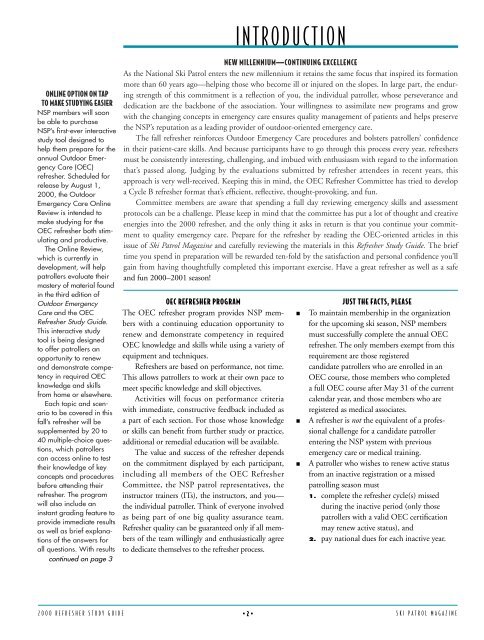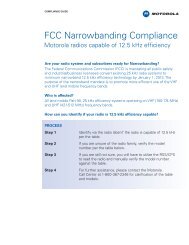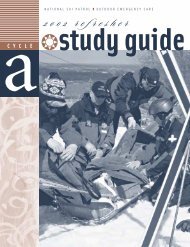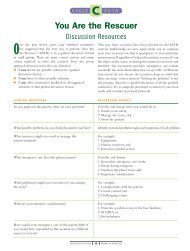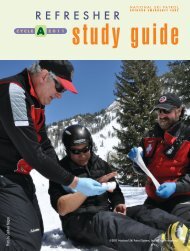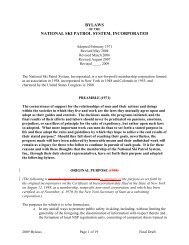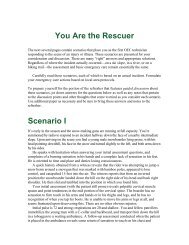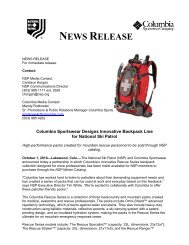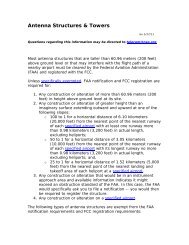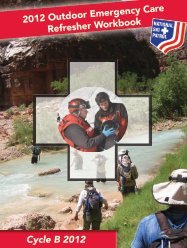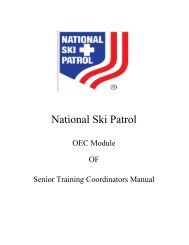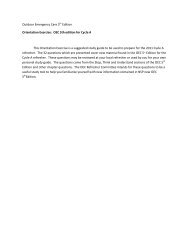INTRODUCTION - National Ski Patrol
INTRODUCTION - National Ski Patrol
INTRODUCTION - National Ski Patrol
You also want an ePaper? Increase the reach of your titles
YUMPU automatically turns print PDFs into web optimized ePapers that Google loves.
ONLINE OPTION ON TAP<br />
TO MAKE STUDYING EASIER<br />
NSP members will soon<br />
be able to purchase<br />
NSP’s first-ever interactive<br />
study tool designed to<br />
help them prepare for the<br />
annual Outdoor Emergency<br />
Care (OEC)<br />
refresher. Scheduled for<br />
release by August 1,<br />
2000, the Outdoor<br />
Emergency Care Online<br />
Review is intended to<br />
make studying for the<br />
OEC refresher both stimulating<br />
and productive.<br />
The Online Review,<br />
which is currently in<br />
development, will help<br />
patrollers evaluate their<br />
mastery of material found<br />
in the third edition of<br />
Outdoor Emergency<br />
Care and the OEC<br />
Refresher Study Guide.<br />
This interactive study<br />
tool is being designed<br />
to offer patrollers an<br />
opportunity to renew<br />
and demonstrate competency<br />
in required OEC<br />
knowledge and skills<br />
from home or elsewhere.<br />
Each topic and scenario<br />
to be covered in this<br />
fall’s refresher will be<br />
supplemented by 20 to<br />
40 multiple-choice questions,<br />
which patrollers<br />
can access online to test<br />
their knowledge of key<br />
concepts and procedures<br />
before attending their<br />
refresher. The program<br />
will also include an<br />
instant grading feature to<br />
provide immediate results<br />
as well as brief explanations<br />
of the answers for<br />
all questions. With results<br />
continued on page 3<br />
<strong>INTRODUCTION</strong><br />
NEW MILLENNIUM—CONTINUING EXCELLENCE<br />
As the <strong>National</strong> <strong>Ski</strong> <strong>Patrol</strong> enters the new millennium it retains the same focus that inspired its formation<br />
more than 60 years ago—helping those who become ill or injured on the slopes. In large part, the enduring<br />
strength of this commitment is a reflection of you, the individual patroller, whose perseverance and<br />
dedication are the backbone of the association. Your willingness to assimilate new programs and grow<br />
with the changing concepts in emergency care ensures quality management of patients and helps preserve<br />
the NSP’s reputation as a leading provider of outdoor-oriented emergency care.<br />
The fall refresher reinforces Outdoor Emergency Care procedures and bolsters patrollers’ confidence<br />
in their patient-care skills. And because participants have to go through this process every year, refreshers<br />
must be consistently interesting, challenging, and imbued with enthusiasm with regard to the information<br />
that’s passed along. Judging by the evaluations submitted by refresher attendees in recent years, this<br />
approach is very well-received. Keeping this in mind, the OEC Refresher Committee has tried to develop<br />
a Cycle B refresher format that’s efficient, reflective, thought-provoking, and fun.<br />
Committee members are aware that spending a full day reviewing emergency skills and assessment<br />
protocols can be a challenge. Please keep in mind that the committee has put a lot of thought and creative<br />
energies into the 2000 refresher, and the only thing it asks in return is that you continue your commitment<br />
to quality emergency care. Prepare for the refresher by reading the OEC-oriented articles in this<br />
issue of <strong>Ski</strong> <strong>Patrol</strong> Magazine and carefully reviewing the materials in this Refresher Study Guide. The brief<br />
time you spend in preparation will be rewarded ten-fold by the satisfaction and personal confidence you’ll<br />
gain from having thoughtfully completed this important exercise. Have a great refresher as well as a safe<br />
and fun 2000–2001 season!<br />
OEC REFRESHER PROGRAM<br />
The OEC refresher program provides NSP members<br />
with a continuing education opportunity to<br />
renew and demonstrate competency in required<br />
OEC knowledge and skills while using a variety of<br />
equipment and techniques.<br />
Refreshers are based on performance, not time.<br />
This allows patrollers to work at their own pace to<br />
meet specific knowledge and skill objectives.<br />
Activities will focus on performance criteria<br />
with immediate, constructive feedback included as<br />
a part of each section. For those whose knowledge<br />
or skills can benefit from further study or practice,<br />
additional or remedial education will be available.<br />
The value and success of the refresher depends<br />
on the commitment displayed by each participant,<br />
including all members of the OEC Refresher<br />
Committee, the NSP patrol representatives, the<br />
instructor trainers (ITs), the instructors, and you—<br />
the individual patroller. Think of everyone involved<br />
as being part of one big quality assurance team.<br />
Refresher quality can be guaranteed only if all members<br />
of the team willingly and enthusiastically agree<br />
to dedicate themselves to the refresher process.<br />
■<br />
■<br />
■<br />
JUST THE FACTS, PLEASE<br />
To maintain membership in the organization<br />
for the upcoming ski season, NSP members<br />
must successfully complete the annual OEC<br />
refresher. The only members exempt from this<br />
requirement are those registered<br />
candidate patrollers who are enrolled in an<br />
OEC course, those members who completed<br />
a full OEC course after May 31 of the current<br />
calendar year, and those members who are<br />
registered as medical associates.<br />
A refresher is not the equivalent of a professional<br />
challenge for a candidate patroller<br />
entering the NSP system with previous<br />
emergency care or medical training.<br />
A patroller who wishes to renew active status<br />
from an inactive registration or a missed<br />
patrolling season must<br />
1. complete the refresher cycle(s) missed<br />
during the inactive period (only those<br />
patrollers with a valid OEC certification<br />
may renew active status), and<br />
2. pay national dues for each inactive year.<br />
2000 REFRESHER STUDY GUIDE 2<br />
SKI PATROL MAGAZINE
■<br />
■<br />
■<br />
■<br />
■<br />
■<br />
■<br />
■<br />
HOW TO PREPARE<br />
Allow yourself plenty of time to study the<br />
Outdoor Emergency Care references listed in<br />
this study guide for Cycle B. Please note that<br />
all references are to the third edition of OEC.<br />
After studying these references, review the<br />
objectives presented with the refresher topics.<br />
Then answer the questions for each scenario<br />
found in the Scenario Discussion Forum<br />
section of this study guide. (You may find it<br />
helpful to cite text references in the space<br />
provided.) Be sure to bring the completed<br />
study guide to the refresher.<br />
Use the skill performance guidelines in this<br />
study guide and in the third edition OEC<br />
Study Book to review and practice the skills<br />
you will be asked to demonstrate during this<br />
year’s refresher.<br />
Check with your patrol or region to determine<br />
when and where the refresher will be held. If<br />
you have a conflict, contact the OEC region<br />
administrator for an alternate date. Do not wait<br />
until the last minute to do this. It is your<br />
responsibility to find out when the refresher<br />
is being held.<br />
Review and follow local instructions with<br />
regard to study, review, information references,<br />
and refresher logistics.<br />
WHAT TO BRING TO THE REFRESHER<br />
This 2000 Refresher Study Guide. Remember<br />
to complete your written answers to the<br />
scenario text and action questions before<br />
you arrive.<br />
Your current OEC, CPR, and NSP registration<br />
cards. (You may obtain a duplicate<br />
OEC card from the national office by mailing<br />
a check or money order for $4 made<br />
payable to NSP, 133 S. Van Gordon St.,<br />
Suite 100, Lakewood, CO 80228. Enclose<br />
a note asking for a new OEC card and allow<br />
three to four weeks for delivery.)<br />
A fully stocked aid belt, vest, or pack and<br />
any additional items required at the refresher<br />
you will be attending. Dress appropriately to<br />
participate in both indoor and outdoor<br />
refresher activities.<br />
■<br />
■<br />
REFRESHER FOLLOW-UP<br />
Complete and hand in the “<strong>Patrol</strong>ler Evaluation<br />
for the 2000 OEC Refresher” found in<br />
this study guide.<br />
If you attend another region or patrol’s refresher,<br />
be sure the instructor of record has all the<br />
necessary information to verify your completion<br />
of the refresher to the national office on<br />
a supplemental roster. The roster must include<br />
your NSP membership I.D. number, name<br />
(as it appears in national registration records),<br />
patrol identification, and address. You may also<br />
want to use the verification form at the end of<br />
this guide to document your attendance to<br />
your patrol representative.<br />
CPR AND AED POLICY<br />
A. All active NSP members must hold a current<br />
professional-rescuer CPR certification from<br />
the American Heart Association, the American<br />
Red Cross, or the <strong>National</strong> Safety Council.<br />
This must include training in two-rescuer<br />
CPR techniques.<br />
B. All active NSP members must demonstrate<br />
their CPR skills each season, regardless of the<br />
certifying agency’s requirements or the expiration<br />
date of the card. The <strong>National</strong> Medical Committee<br />
stresses the importance of participating<br />
in this CPR skills refresher because repetition<br />
and practice help develop competency. A new<br />
certificate need not be issued by the certifying<br />
body unless the certificate expires before the<br />
start of the upcoming ski season.<br />
C. CPR training may be completed in an independent<br />
patrol session, accomplished by each<br />
patroller on an individual basis, or included as<br />
a part of the OEC refresher. If CPR training<br />
is conducted in a patrol session or at an OEC<br />
refresher, organizers must allow appropriate<br />
CPR review time and use the instructional<br />
standards for updating cardholders provided<br />
by the chapter or affiliate in accordance with<br />
guidelines established in the Journal of the<br />
American Medical Association, October 1992.<br />
D. With regard to the use of automated external<br />
defibrillators (AEDs), the American Heart<br />
Association recommends AED training for<br />
rescuers who respond to incidents in high-risk<br />
environments. At this time, AED concepts are<br />
included in most CPR courses. AED skills<br />
continued from page 2<br />
of the review in hand,<br />
patrollers will be able to<br />
reduce their training time<br />
at their local refreshers<br />
this fall. In addition, the<br />
program will provide<br />
page references to the<br />
Outdoor Emergency<br />
Care text and hyperlinks<br />
to other medical sites<br />
for those who wish to<br />
learn more about specific<br />
topics.<br />
The OEC Online<br />
Review will be found at<br />
www.nspoec.com. Once<br />
at the site, NSP members<br />
will simply click on the<br />
Outdoor Emergency Care<br />
Online Review tab and<br />
purchase access to the<br />
site for a one-time charge<br />
of $9.95 (via a secure,<br />
encrypted order form).<br />
The member will then<br />
have access to the program<br />
for six months from<br />
the date of purchase.<br />
The OEC Online Review<br />
is the first product offered<br />
through an exciting new<br />
relationship between the<br />
NSP and Jones and<br />
Bartlett Publishers (J&B).<br />
For each unit of the<br />
review sold, J&B will<br />
pay a royalty to NSP to<br />
benefit the organization’s<br />
education programs.<br />
The NSP and J&B have<br />
also partnered to develop<br />
the fourth edition of<br />
Outdoor Emergency<br />
Care. This alliance<br />
promises to foster the<br />
development of many<br />
new methods of delivering<br />
OEC materials—<br />
including electronic<br />
teaching tools—to help<br />
patrollers enhance<br />
their skills.<br />
SKI PATROL MAGAZINE 3<br />
2000 REFRESHER STUDY GUIDE
THE TOP 10 REASONS<br />
WHY PATROLLERS CAN’T<br />
WAIT TO GO TO THEIR<br />
REFRESHERS<br />
10. Since the grass is<br />
almost done growing,<br />
they really have nothing<br />
better to do over the<br />
weekend.<br />
9. For weeks, they’ve<br />
been looking for a good<br />
excuse to get up at the<br />
crack of dawn.<br />
8. They enjoy running<br />
around aimlessly at 8 in<br />
the morning with dozens<br />
of other people who pretend<br />
to remember this<br />
stuff like they did it just<br />
yesterday.<br />
7. They get<br />
paid so well<br />
for being<br />
there.<br />
6. The coffee, tea, and<br />
donuts alone are worth<br />
the drive.<br />
5. They can sit,<br />
crammed together, in<br />
one guy’s car and do<br />
the written part of the<br />
Refresher Study Guide<br />
on the way to the<br />
ski area.<br />
training, where provided, is taught as an addon<br />
option in citizen-level and professionalrescuer<br />
courses. <strong>Patrol</strong>lers are reminded that<br />
they must obtain ski area management<br />
approval to practice with and use AEDs.<br />
Furthermore, any such use must be conducted<br />
in accordance with statutes and protocols<br />
established by state and local authorities.<br />
OEC REFRESHER TOPICS AND OBJECTIVES<br />
The six core topics that follow are essential subjects and skills that apply to all emergency care situations.<br />
<strong>Patrol</strong>lers must review and demonstrate proficiency in all core subjects each year.<br />
A. CORE TOPICS AND OBJECTIVES<br />
1. Shock Management (2000 focus area)<br />
■ Provide an in-depth review of the anatomy and physiology of the circulatory system, as well as<br />
the different types of shock, their causes, and emergency treatment.<br />
■ Be able to recognize the potential for shock and its signs and symptoms.<br />
■ Demonstrate techniques to prevent and manage shock.<br />
2. Cold-Injury Management (2000 focus area)<br />
■ Provide an in-depth review of the body’s heat production mechanism, hypothermia, and other<br />
illnesses and injuries related to the cold environment.<br />
■ Be able to recognize and discuss the signs and symptoms of cold-related injuries, including<br />
hypothermia.<br />
■ Demonstrate techniques to manage patients with hypothermia or other cold-related illnesses<br />
or injuries.<br />
3. Airway Management and Oxygen Administration<br />
■ Demonstrate airway management techniques and the correct application and use of airway<br />
adjuncts, oxygen administration, and suction equipment.<br />
4. Patient Assessment: Rapid Body Survey, Focused Trauma Survey<br />
■ Demonstrate assessment techniques for an injured person, using the Patient Assessment—<br />
Rapid Body Survey and Patient Assessment—Responsive—Injured (Trauma) skill<br />
performance guidelines.<br />
5. Infection Control<br />
■ Demonstrate the correct application of body substance isolation (BSI) to minimize exposure<br />
to body fluids in all applicable patient care situations.<br />
6. Neurological Injury Management<br />
■ Demonstrate the ability to recognize patients with head and/or spinal injuries.<br />
■ Integrate the application of spinal immobilization techniques and devices in other refresher<br />
scenarios and stations.<br />
B. GENERAL TOPICS AND OBJECTIVES<br />
1. Anatomy and Physiology<br />
a. Circulatory system—List and be able to describe the major structures and functions of the<br />
circulatory system and how it interacts with other body systems in health, disease, and injury.<br />
b. Cutaneous system—List and be able to describe the major structures and functions of the<br />
cutaneous system and how it interacts with other body systems in health, disease, and injury.<br />
2. Orthopedic Trauma<br />
Upper-extremity injuries, injuries at or near joints, and open fractures—Describe the signs and symptoms<br />
and principles of emergency care for upper-extremity injuries. Review the mechanism and<br />
pattern of upper-extremity injuries, injuries at or near joints, and open fractures. Using the applicable<br />
skill performance guidelines, demonstrate the proper assessment and correct application of<br />
various immobilization techniques and devices for the shoulder, upper arm, elbow, forearm, wrist,<br />
and hand. Demonstrate the correct management of injuries at or near a joint. Demonstrate the<br />
correct management of an open fracture before and during immobilization.<br />
2000 REFRESHER STUDY GUIDE 4<br />
SKI PATROL MAGAZINE
3. Environmental and Medical Emergencies<br />
Environmental injuries—List and describe the injuries and illnesses caused by the environmental<br />
factors listed below. Describe the causes, signs and symptoms, and essential emergency care for each.<br />
a. Cold b. Heat c. Altitude d. Solar e. Electrical<br />
4. Specific Injuries<br />
a. Bleeding—Demonstrate techniques for managing and controlling external bleeding and all<br />
soft-tissue injuries.<br />
b. Burns—Demonstrate essential emergency care for thermal burns.<br />
c. Bandaging—Demonstrate general bandaging techniques.<br />
5. Transportation and Extrication<br />
Positioning patients—Review the advantages and disadvantages of positioning, lifting, and/or moving<br />
a patient using the three positions of “jams and pretzels.” Demonstrate each of these positions,<br />
using the correct technique.<br />
6. Local Needs<br />
Review applicable local requirements, topics, and equipment related to the performance of<br />
outdoor emergency care at the patrol level. The OEC instructor of record reviews these concepts<br />
with patrol officers and the medical advisor to determine how to integrate applicable techniques<br />
or equipment into the current OEC refresher.<br />
Specific area emergency care training may be accomplished at this time, including AED<br />
skills training as appropriate. Organizers may need to lengthen the overall refresher program to<br />
adequately cover these subjects. This objective is not to be confused with additional local training<br />
for patrol operations, such as lift evacuation, commonly referred to and accomplished in a<br />
separate on-the-hill refresher.<br />
CORE TOPICS<br />
STUDY REFERENCES<br />
OEC TEXT AND STUDY BOOK, THIRD EDITION<br />
Shock Management (focus area) Chapter 7<br />
Cold Injury Management (focus area) Chapter 19<br />
Airway Management and Oxygen Administration Chapter 6<br />
Patient Assessment Chapters 4, 5, 20, and 21<br />
(Chapter 20 is included as a reference<br />
for pediatric assessment.)<br />
Infection Control<br />
Chapter 4 and Appendix F<br />
Neurological Injury Management Chapters 13 and 14<br />
4. They can’t wait to see<br />
what goofy things the<br />
instructors are going to<br />
have them do at the<br />
stations this year.<br />
3. They heard a rumor<br />
that their new, goodlooking<br />
patrol representative<br />
has volunteered to<br />
be a patient for the<br />
rapid body grope.<br />
2. Enough time has<br />
passed since the last<br />
refresher that they’ve<br />
completely forgotten the<br />
pain of being strapped<br />
to the spineboard and<br />
having the Hare traction<br />
splint incorrectly seated<br />
against their “dainty<br />
parts.”<br />
GENERAL TOPICS<br />
OEC TEXT AND STUDY BOOK, THIRD EDITION<br />
Anatomy and Physiology Chapter 2<br />
Circulatory System<br />
Cutaneous System<br />
Orthopedic Trauma Chapters 9, 10, 11, and 12<br />
Upper Extremity Injuries, Injuries At or<br />
Near a Joint, and Open Fractures<br />
Environmental and Medical Emergencies Chapter 19<br />
Environmental Emergencies<br />
Specific Injuries Chapters 7 and 8<br />
Control of Serious Bleeding, Burns, Bandaging<br />
Extrication and Transport Chapter 22<br />
Extrication from Difficult Positions,<br />
Jams and Pretzels<br />
And the #1 reason<br />
patrollers can’t wait to<br />
go to their refreshers:<br />
1. They heard their<br />
patrol representative is<br />
buying the beer when<br />
it’s over.<br />
SKI PATROL MAGAZINE 5<br />
2000 REFRESHER STUDY GUIDE
SKILL PERFORMANCE GUIDELINES<br />
These are provided for review purposes. Each patroller will be required to demonstrate these skills at the refresher.<br />
(CPI) = Critical Performance Indicator<br />
Steps marked with the CPI designation are critical to proper patient care and must be demonstrated to satisfy performance criteria.<br />
MANAGING MEDICAL AND ENVIRONMENTAL EMERGENCIES<br />
OBJECTIVE: To demonstrate the skills needed to assess and manage illnesses that develop suddenly and require emergency care intervention.<br />
SKILL YES NO NOTATIONS<br />
■ Determines level of responsiveness (LOR) by using the AVPU Scale. (CPI)<br />
■ Performs urgent survey and provides priority emergency (CPI)<br />
care intervention.<br />
■ Provides general care for unresponsiveness, as appropriate. (CPI)<br />
■<br />
Provides care for irrational, excited patients.<br />
■ Does not attempt to restrain patient.<br />
■ Provides care for seizures.<br />
■ Provides care for diabetic emergencies, if indicated.<br />
■ Does not leave patient unattended.<br />
■ Obtains the medical (SAMPLE) history. Obtains initial vital signs. (CPI)<br />
Looks for medical-alert identification if no history is available.<br />
■<br />
■<br />
■<br />
■<br />
■<br />
Helps patient take any medication that has been prescribed for<br />
illness if not contraindicated by the patient’s condition or circumstance<br />
and if in accordance with local protocols.<br />
Arranges for transportation to a medical facility.<br />
Maintains patient in a comfortable position.<br />
Provides protection from the environment, including any necessary<br />
warming or cooling.<br />
Provides treatment appropriate for the medical illness, including<br />
oxygen administration.<br />
■ Monitors vital signs at regular intervals, being alert for changes (CPI)<br />
in the respiratory and circulatory systems.<br />
Did the trainee or patroller adequately demonstrate the<br />
performance criteria of this skill<br />
2000 REFRESHER STUDY GUIDE 6<br />
SKI PATROL MAGAZINE
USE OF OXYGEN AND AIRWAY ADJUNCTS—ADMINISTRATION OF OXYGEN<br />
OBJECTIVE:<br />
To demonstrate the correct use of oxygen equipment.<br />
SKILL YES NO NOTATIONS<br />
■ Assembles oxygen cylinder and regulator, and checks for leaks. (CPI)<br />
■ Chooses a delivery device by patient need. (CPI)<br />
■ Selects non-rebreather oxygen mask, connects to regulator,<br />
initially adjusts oxygen flow to 15 lpm, readjusting to keep<br />
the bag half-full on inhalation.<br />
■ Selects nasal cannula, connects to regulator, and adjusts<br />
oxygen to 6 lpm maximum.<br />
■ Applies oxygen delivery device to patient and verifies that the patient (CPI)<br />
receives oxygen.<br />
■<br />
When complete, closes oxygen tank.<br />
■ Bleeds regulator device to “0.”<br />
Did the trainee or patroller adequately demonstrate the<br />
performance criteria of this skill<br />
SKI PATROL MAGAZINE 7<br />
2000 REFRESHER STUDY GUIDE
PATIENT ASSESSMENT—BODY SURVEY (RAPID AND WHOLE)<br />
OBJECTIVE:<br />
To demonstrate the ability to perform a body survey on a patient rapidly on scene or in a comfortable environment.<br />
SKILL YES NO NA NOTATIONS<br />
■ Assesses the patient’s level of responsiveness (AVPU). (CPI)<br />
■ Obtains the SAMPLE history. (CPI)<br />
■ Guards the cervical spine, as appropriate. (CPI)<br />
■ Confirms the ABCs. (CPI)<br />
■ Confirms control of severe bleeding. (CPI)<br />
■<br />
■<br />
■<br />
■<br />
■<br />
■<br />
■<br />
■<br />
Examines the head (skull, facial bones, pupils, ears, nose, and mouth).<br />
Examines and palpates the neck (cervical spine and anterior neck),<br />
and looks for medical-alert identification.<br />
Examines and palpates the chest (for abnormality and deformity).<br />
Examines and palpates the abdomen (all quadrants).<br />
Examines and palpates the pelvis.<br />
Examines and palpates each lower extremity (for abnormality<br />
and circulatory and neurologic function), and looks for<br />
medical-alert identification.<br />
Examines and palpates each upper extremity (for abnormality<br />
and circulatory and neurologic function), and looks for<br />
medical-alert identification.<br />
Examines and palpates the back and buttocks.<br />
■ Determines the pulse and respiration rates. (CPI)<br />
■ Forms general impression. (CPI)<br />
■<br />
Did the trainee or patroller adequately demonstrate the<br />
performance criteria of these skills<br />
2000 REFRESHER STUDY GUIDE 8<br />
SKI PATROL MAGAZINE
PATIENT ASSESSMENT—RESPONSIVE PATIENT—INJURED (TRAUMA)<br />
OBJECTIVE: To demonstrate the ability to determine the baseline condition and specific injury or injuries in a responsive injured patient.<br />
SKILL YES NO NA NOTATIONS<br />
FIRST IMPRESSION<br />
■ Notes the presence of hazards or obstacles. (CPI)<br />
■<br />
Notes the number of patients and the level of responsiveness.<br />
■ Determines the nature of the incident and the mechanism (CPI)<br />
of injury (MOI).<br />
■<br />
■<br />
■<br />
Evaluates the need to access or extricate the patient(s).<br />
Notes the need for personnel or equipment.<br />
Initiates BSI precautions.<br />
URGENT SURVEY—RESPONSIVE PATIENT<br />
■<br />
■<br />
Offers to assist.<br />
Assesses ABCs.<br />
■ Observes the patient for severe bleeding. (CPI)<br />
Intervention = control severe bleeding.<br />
■<br />
Observes the patient’s expression and skin condition.<br />
■ Obtains chief complaint. (CPI)<br />
■<br />
■<br />
Calls for transport, equipment, assistance, and/or EMS as needed.<br />
Obtains trauma history (DCAP-BTLS) and confirms MOI.<br />
■ Conducts a focused body survey of the area of chief complaint, (CPI)<br />
confirms chief complaint.<br />
■<br />
■<br />
■<br />
Stabilizes and maintains body temperature.<br />
Determines the pulse and respiration rates.<br />
If patient has abnormal ABCs, significant MOI, or presents a poor<br />
general impression, rescuer performs rapid body survey, SAMPLE<br />
history, interventions, and rapid transport.<br />
■ Provides care for the chief complaint. Conducts intervention(s) (CPI)<br />
as needed.<br />
■<br />
■<br />
Transports the patient off the hill.<br />
Performs the ongoing survey while awaiting transport (if possible).<br />
Did the trainee or patroller adequately demonstrate the<br />
performance criteria of these skills<br />
SKI PATROL MAGAZINE 9<br />
2000 REFRESHER STUDY GUIDE
GENERAL MANAGEMENT OF A FRACTURE AT OR NEAR A JOINT<br />
OBJECTIVE: To demonstrate the immobilization of a fracture site, the adjacent joints, and the extremity for a fracture or dislocation<br />
at or near a joint.<br />
■<br />
■<br />
■<br />
■<br />
SKILL YES NO NOTATIONS<br />
Assesses the limb, joint, and mechanism of injury (MOI) to<br />
determine the presence and location of a fracture and/or dislocation.<br />
Assesses the circulatory and neurological function of the limb.<br />
Manually stabilizes the fracture site and the limb.<br />
(Note: Continuous manual stabilization must be maintained<br />
until a mechanical device is applied and completely secured.)<br />
Moves the limb toward a nearer-anatomically correct position,<br />
if possible, with the assistance of the patient.<br />
■ If there is no distal circulation, aligns limb until resistance is met (CPI)<br />
or circulation returns.<br />
■<br />
■<br />
Prepares the immobilization device for use, taking into account<br />
any unusual anatomical positioning of the limb.<br />
Positions the device without excessive movement of the limb.<br />
■ Applies and secures the device to the limb and body without (CPI)<br />
excessive movement, ensuring that all voids are filled, and checks<br />
to make sure that the fracture site, the adjacent joints, and the<br />
limb are immobilized.<br />
■<br />
Reassesses the circulatory and neurological function of the limb.<br />
Did the trainee or patroller adequately demonstrate the<br />
performance criteria of this skill<br />
2000 REFRESHER STUDY GUIDE 10<br />
SKI PATROL MAGAZINE
MANAGEMENT OF AN OPEN FRACTURE<br />
OBJECTIVE:<br />
To demonstrate the control of severe bleeding associated with an open fracture.<br />
SKILL YES NO NOTATIONS<br />
■ Uses BSI precautions according to local protocols. (CPI)<br />
■<br />
■<br />
Assesses the limb, identifying the presence of an open fracture<br />
as well as its severity and stability.<br />
Assesses the circulatory and neurological function of the extremity,<br />
if not contraindicated by severe bleeding.<br />
■ Begins to control any severe bleeding. (CPI)<br />
■<br />
■<br />
Manually stabilizes the fracture site and the limb.<br />
Aligns the limb to near-anatomically correct position.<br />
■ Controls any bleeding that is present. (CPI)<br />
■ Exposes the fracture site.<br />
■ Uses direct and indirect pressure.<br />
■ Uses the pressure point, if necessary.<br />
■ Applies a dressing over the wound.<br />
■<br />
Cleans and irrigates the wound according to local protocol.<br />
■ Dresses and initially bandages the wound with pressure as needed. (CPI)<br />
■<br />
■<br />
■<br />
Immobilizes the limb and adjacent joints, maintaining elevation<br />
if possible.<br />
Applies final bandaging of the wound after immobilization.<br />
Reassesses the circulatory and neurological function of the extremity.<br />
Did the trainee or patroller adequately demonstrate the<br />
performance criteria of this skill<br />
(CPI)<br />
SKI PATROL MAGAZINE 11<br />
2000 REFRESHER STUDY GUIDE
OBJECTIVE: To demonstrate the ability to control severe bleeding.<br />
CONTROL OF SEVERE BLEEDING IN A WOUND<br />
SKILL YES NO NOTATIONS<br />
■ Uses BSI precautions according to local protocols. (CPI)<br />
■<br />
■<br />
Recognizes the severity of the bleeding and gives it proper priority.<br />
Exposes the wound site.<br />
■ Applies direct pressure. (CPI)<br />
■<br />
■<br />
■<br />
Elevates the wound site above the level of the heart.<br />
Maintains direct pressure and elevation.<br />
Applies direct pressure to the appropriate pressure point if bleeding<br />
has not been controlled.<br />
■ Checks that the bleeding has been controlled. (CPI)<br />
■<br />
Immobilizes as necessary.<br />
Did the trainee or patroller adequately demonstrate the<br />
performance criteria of this skill<br />
2000 REFRESHER STUDY GUIDE 12<br />
SKI PATROL MAGAZINE
SCENARIO DISCUSSION FORUM<br />
Based on responses recorded in last fall’s Refresher Evaluations,<br />
the new Scenario Discussion Forum station was a resounding<br />
success! Refresher participants appreciated the more realistic<br />
approach to emergency care situations afforded by the required<br />
“timeline” responses. Also, many respondents voiced satisfaction<br />
at being able to discuss and share their thoughts about difficult<br />
injury/illness problems with fellow patrollers.<br />
To complete this segment of the study guide, first carefully<br />
read the following four scenarios. Then, use the space provided to<br />
answer the “text questions” relating to the script of each scenario.<br />
Use additional paper if necessary. Feel free to research these topics<br />
in the third edition of Outdoor Emergency Care. Next, answer the<br />
two “action questions” that follow each scenario. Finally, bring<br />
these Scenario Discussion Forum sheets with you to your refresher for<br />
use and reference at this station.<br />
g.<br />
h.<br />
OEC p. ______<br />
2. Key assessment signs that indicate the depth of hypothermia are<br />
Mild (Body core temperature of 90–95° F)<br />
a.<br />
b.<br />
c.<br />
d.<br />
e.<br />
f.<br />
SCENARIO I<br />
It’s late in the day and an 11-year-old girl is practicing freestyle<br />
snowboarding tricks in a terrain park. Even though the temperature<br />
is 34° F and a light rain is falling, the girl isn’t wearing a<br />
hat. She’s been pushing the upper limits of her abilities all day,<br />
and as she approaches a flattop hit, she falls forward onto her<br />
right arm, with the elbow partially flexed.<br />
You’re dispatched to the scene and when you arrive with a<br />
toboggan the girl is sitting up, shivering violently, crying, and<br />
cradling her right forearm to her chest. In soft and halting speech,<br />
she complains of pain in her right elbow. You ask a witness if the<br />
girl has shown any loss of responsiveness and he says no.<br />
A rapid body survey reveals that the girl responds slowly and<br />
is oriented to place only. Her right elbow feels deformed on palpation<br />
of the apex (olecranon process) and it’s “locked” in 50<br />
degrees of flexion. Circulation, motion, and sensation in the right<br />
hand are normal.<br />
A medical-alert bracelet on the girl’s right wrist indicates<br />
that she’s diabetic. You ask when she last took her insulin, and<br />
she says she can’t remember if she had it that morning or not.<br />
TEXT QUESTIONS<br />
1. Medical conditions or substances that can make a person<br />
more susceptible to hypothermia include<br />
a.<br />
b.<br />
c.<br />
d.<br />
e.<br />
f.<br />
Severe (Body core temperature of 80–90° F)<br />
a.<br />
b.<br />
c.<br />
d.<br />
e.<br />
f.<br />
g.<br />
h.<br />
Body core temperature of less than 80° F<br />
a.<br />
b.<br />
c.<br />
d.<br />
e.<br />
f.<br />
g.<br />
OEC p. ______<br />
3. Emergency treatment of a hypothermic patient includes<br />
a.<br />
b.<br />
c.<br />
d.<br />
e.<br />
OEC p. ______<br />
SKI PATROL MAGAZINE 13<br />
2000 REFRESHER STUDY GUIDE
4. Assessment signs that suggest a joint dislocation include<br />
a.<br />
b.<br />
c.<br />
d.<br />
e.<br />
OEC p. ______<br />
ACTION QUESTIONS<br />
1. Please record all injuries and medical conditions described in<br />
this scenario.<br />
shoulder. His right mid-forearm, which is shortened and angulated,<br />
is swollen and tender, and the fingers on his right hand are<br />
pale. You find no radial pulse on the injured side. There are no<br />
other obvious injuries.<br />
Taking the man’s vital signs, you note that the pulse is 120<br />
and strong; his respirations are 22 and deep.<br />
TEXT QUESTIONS<br />
1. Describe the emergency care of a patient with heat stroke.<br />
a.<br />
b.<br />
c.<br />
d.<br />
e.<br />
OEC p. ______<br />
2. List three other types of heat illness.<br />
2. Excluding assessment, list in order the emergency care you<br />
would provide, and note any area management concerns<br />
that might arise from the circumstances described in this<br />
scenario.<br />
a.<br />
b.<br />
c.<br />
d.<br />
e.<br />
f.<br />
g.<br />
h.<br />
i.<br />
j.<br />
SCENARIO II<br />
It’s mid-August and a 28-year-old man is participating in a 30-<br />
mile mountain bike race. He hasn’t paced himself properly and<br />
he’s been lax about staying hydrated. Toward the end of the race,<br />
he grows steadily more fatigued and loses control of his bike on<br />
a downhill grade. Pitching over the handlebars, he lands on his<br />
outstretched right arm and then rolls onto his shoulder.<br />
When you arrive at the scene you find the injured biker<br />
lying supine and supporting his swollen, deformed right forearm<br />
across his abdomen. There was no loss of responsiveness, but a<br />
rapid body survey reveals that the man is confused, complains of<br />
a headache, and has hot, dry, and flushed skin. Upon palpation,<br />
you find an obvious shelf-like deformity at the point of his right<br />
a.<br />
b.<br />
c.<br />
OEC p. ______<br />
3. Conditions/substances that heighten the risk of heat<br />
illnesses include<br />
a.<br />
b.<br />
c.<br />
d.<br />
e.<br />
f.<br />
g.<br />
h.<br />
i.<br />
OEC p. ______<br />
4. What three common injuries to the shoulder girdle require<br />
the upper arm/forearm to be splinted to the chest with a<br />
sling and swathe<br />
a.<br />
b.<br />
c.<br />
OEC pp. ______<br />
2000 REFRESHER STUDY GUIDE 14<br />
SKI PATROL MAGAZINE
ACTION QUESTIONS<br />
1. Please record all injuries and medical conditions described in<br />
this scenario.<br />
TEXT QUESTIONS<br />
1. Some of the primary concerns associated with electrical<br />
burns are<br />
a.<br />
b.<br />
2. Excluding assessment, list in order the emergency care you<br />
would provide, and note any area management concerns<br />
that might arise from the circumstances described in this<br />
scenario.<br />
a.<br />
b.<br />
c.<br />
d.<br />
e.<br />
f.<br />
g.<br />
h.<br />
i.<br />
j.<br />
c.<br />
d.<br />
e.<br />
OEC p. ______<br />
2. Describe the different effects that alternating current (AC)<br />
and direct current (DC) can have on the heart.<br />
a.<br />
b.<br />
OEC p. ______<br />
3. Why are internal injuries often overlooked in electrical<br />
burn patients<br />
k.<br />
l.<br />
SCENARIO III<br />
An area maintenance worker is leaning out of a second-story<br />
window in the lodge, attempting to knock a large snow cornice<br />
off the roof with a metal shovel. He accidentally touches the<br />
main power line with the shovel, and the ensuing electrical jolt<br />
throws him out of the window and onto the hard-packed snow<br />
below.<br />
Rushing to the scene you find that the man, who you estimate<br />
to be in his mid-20s, is unresponsive. His pulse is 130 and<br />
irregular and his respirations are 8. The ring and middle fingers<br />
of his right hand have been amputated by the electrical charge,<br />
and you note full-thickness (third-degree) burns on his right and<br />
left palms. The man has a gaping wound in his right thigh,<br />
which appears to be the electrical exit wound. However, there is<br />
no palpable deformity or instability of the right thigh, and no<br />
other obvious injuries.<br />
OEC p. ______<br />
4. List and describe the three types of thermal burns.<br />
a.<br />
b.<br />
c.<br />
OEC p. ______<br />
ACTION QUESTIONS<br />
1. Please record all injuries and medical conditions described in<br />
this scenario.<br />
OEC p. ______<br />
SKI PATROL MAGAZINE 15<br />
2000 REFRESHER STUDY GUIDE
2. Excluding assessment, list in order the emergency care you<br />
would provide, and note any area management concerns<br />
that might arise from the circumstances described in this<br />
scenario.<br />
a.<br />
b.<br />
c.<br />
d.<br />
e.<br />
f.<br />
e.<br />
OEC p. ______<br />
3. List three corrections the body rapidly initiates to compensate<br />
for the occurrence of shock.<br />
a.<br />
b.<br />
c.<br />
OEC p. ______<br />
4. Summarize the emergency care for shock.<br />
g.<br />
h.<br />
i.<br />
j.<br />
k.<br />
l.<br />
m.<br />
n.<br />
o.<br />
SCENARIO IV<br />
A young woman who looks to be in her late teens enters the aid<br />
room and appears to be very flustered. She tells you her name is<br />
Ashley and in a panicked voice says she mistakenly ate some<br />
peanuts in a brownie that an acquaintance offered her. She gasps<br />
that she’s allergic to peanuts and that the last time she made a<br />
similar mistake she had to be rushed to the hospital.<br />
An urgent survey reveals that the young girl is very anxious,<br />
has facial swelling, and is wheezing. She says that she normally<br />
carries medication but left it in her car today. After conducting a<br />
quick SAMPLE history, you learn that her car is in a nearby<br />
parking lot.<br />
TEXT QUESTIONS<br />
1. The emergency antidote for anaphylactic shock is<br />
OEC p. ______<br />
2. Describe the physical response to an offending allergen.<br />
a.<br />
b.<br />
c.<br />
d.<br />
OEC p. ______<br />
ACTION QUESTIONS<br />
1. Please record all injuries and medical conditions described<br />
in this scenario.<br />
2. Excluding assessment, list in order the emergency care you<br />
would provide, and note any area management concerns<br />
that might arise from the circumstances described in this<br />
scenario.<br />
a.<br />
b.<br />
c.<br />
d.<br />
e.<br />
f.<br />
2000 REFRESHER STUDY GUIDE 16<br />
SKI PATROL MAGAZINE
OEC REFRESHER COMPLETION RECORD<br />
Instructors at the refresher should use this form to indicate<br />
whether the patroller successfully completed the content or skill<br />
objective listed here and described in the study guide. Successful<br />
completion of all requirements and objectives is required to<br />
maintain NSP membership for the upcoming season. The local<br />
patrol may include additional topics, and some of the objectives<br />
may be combined in activities during the refresher.<br />
Note: Items in italics require that each individual demonstrate<br />
and obtain verification of successful performance according<br />
to specific OEC skill performance guidelines.<br />
PRE-REFRESHER ASSIGNMENTS CHECK OFF COMMENTS<br />
■<br />
Scenario Discussion Forum Exercises<br />
■<br />
Other Local Assignments<br />
CORE TOPICS<br />
■<br />
Shock Management (2000 focus area)<br />
■<br />
Cold-Injury Management (2000 focus area)<br />
■<br />
Airway Management and Oxygen Administration<br />
Use of Oxygen and Airway Adjuncts—Administration of Oxygen<br />
■<br />
Patient Assessment<br />
Patient Assessment—Rapid Body Survey<br />
Patient Assessment—Responsive Patient—Injured (Trauma)<br />
■<br />
Infection Control<br />
■<br />
Neurological Injury Management<br />
GENERAL TOPICS FOR 2000<br />
■<br />
Anatomy and Physiology<br />
Circulatory System<br />
Cutaneous System<br />
■<br />
Orthopedic Trauma<br />
■<br />
Upper Extremity Injuries<br />
General Management of a Fracture at or Near a Joint<br />
Management of an Open Fracture<br />
continued<br />
SKI PATROL MAGAZINE 17<br />
2000 REFRESHER STUDY GUIDE
PRE-REFRESHER ASSIGNMENTS CHECK OFF COMMENTS<br />
GENERAL TOPICS FOR 2000 (continued)<br />
■<br />
Environmental and Medical Emergencies<br />
Environmental Emergencies<br />
(for conditions including cold, heat, high altitude,<br />
solar radiation, electrical hazard)<br />
Managing Medical and Environmental Emergencies<br />
■<br />
Specific Injuries<br />
Control of Severe Bleeding in a Wound<br />
Burns<br />
Bandaging<br />
■<br />
Transportation and Extrication<br />
Positioning Patients: “Jams and Pretzels”<br />
■<br />
Local Needs<br />
CPR (if included in the refresher)<br />
■<br />
<strong>Ski</strong>ll Check<br />
■<br />
Certification Expiration<br />
EVALUATION TURNED IN<br />
2000 REFRESHER STUDY GUIDE 18<br />
SKI PATROL MAGAZINE
Have this signed by the instructor of record at the refresher, and return it to your NSP patrol representative or patrol director to verify<br />
that you have attended and successfully completed all requirements for the 2000 refresher. Please print.<br />
<strong>Patrol</strong>ler:<br />
NSP Member I.D. #:<br />
<strong>Ski</strong> <strong>Patrol</strong> Registered With:<br />
2000 OEC REFRESHER<br />
COMPLETION ACKNOWLEDGEMENT<br />
Refresher Location and Date:<br />
OEC Instructor of Record (please print name):<br />
Signature:<br />
CUT HERE<br />
✁<br />
After completing the refresher, fill out this form and submit it to the instructor of record. This will help the instructor document<br />
your completion of this year’s OEC refresher requirements to the national office. Please print.<br />
<strong>Patrol</strong>ler:<br />
NSP Member I.D. #:<br />
Address:<br />
City: State: Zip:<br />
E-mail Address:<br />
<strong>Ski</strong> <strong>Patrol</strong> Registered With:<br />
2000 OEC REFRESHER<br />
SUPPLEMENTAL ROSTER INFORMATION<br />
Region:<br />
Refresher Location and Date:<br />
OEC Instructor of Record (please print name):<br />
SKI PATROL MAGAZINE 19<br />
2000 REFRESHER STUDY GUIDE
NOTES<br />
2000 REFRESHER STUDY GUIDE 20<br />
SKI PATROL MAGAZINE
PATROLLER EVALUATION FOR THE 2000 OEC REFRESHER<br />
This evaluation is designed to help local instructors, patrol officers, and the national organization review and improve the annual<br />
OEC refresher. Last year’s responses were greatly appreciated, and many of them have been implemented in this refresher. We look<br />
forward to receiving your feedback again this year.<br />
DIVISION: PATROL: NAME (OPTIONAL):<br />
1. Refresher Overall<br />
WHAT DID YOU LIKE BEST<br />
WHAT NEEDS IMPROVEMENT<br />
2. Facilities<br />
3. Quality of Presenters<br />
and Presentations<br />
4. <strong>Ski</strong>ll Stations<br />
5. Refresher Study Guide<br />
6. Refresher Study Guide<br />
Scenario Discussion Forum<br />
ADDITIONAL COMMENTS:<br />
Please return this evaluation to the refresher instructor of record before you leave the refresher.<br />
SKI PATROL MAGAZINE 21<br />
2000 REFRESHER STUDY GUIDE


